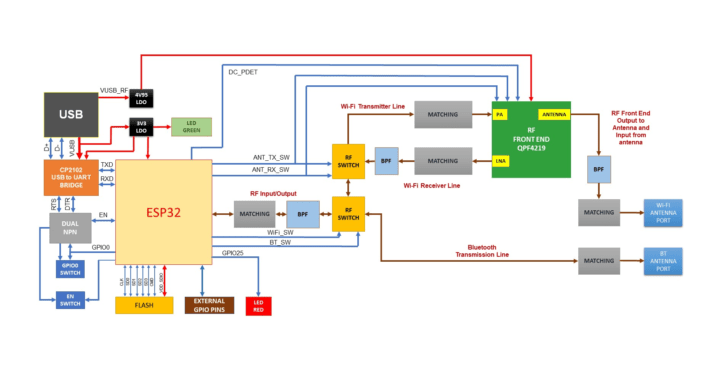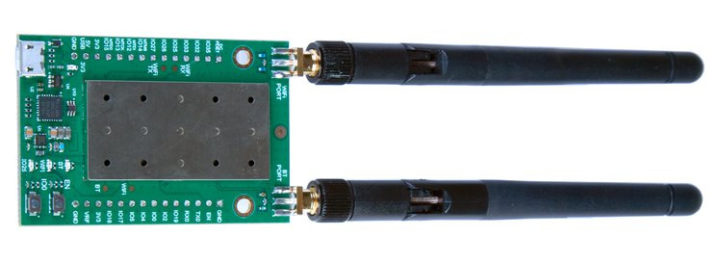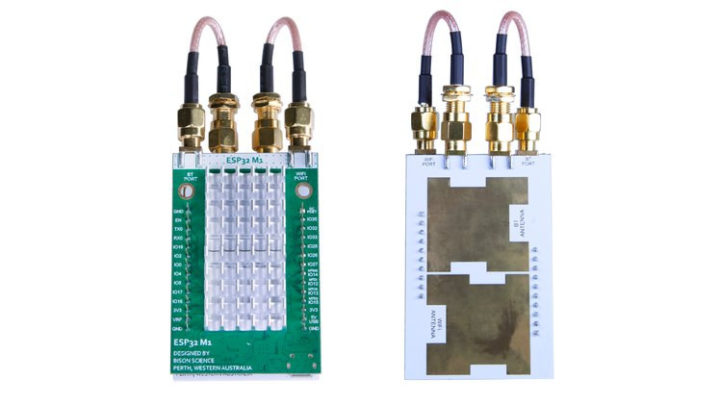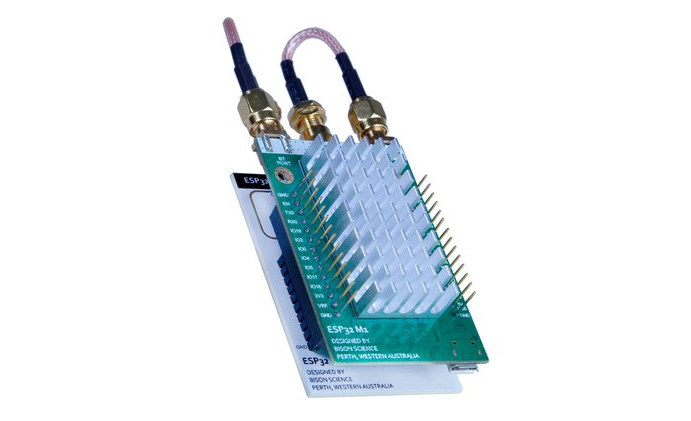WiFi is not really designed for kilometer range transmission, but CNLohr previously demonstrated 1km range with ESP8266, and some directional antennas are sold to expand the WiFi range.
Bison Science’s ESP32-M1 Reach Out WiFi development board has been specifically designed for long-range connectivity with up to 30 dBm (1W) transmit power and support for various types of antennas for a 1.2-kilometer range, even tested up to 1.5km in a clear day.
ESP32-M1 Reach Out features and specifications:
- WiSoC – Espressif Systems ESP32-D0WDQ6 dual-core processor @ 240 MHz
- Storage – 32 Mbit flash
- Connectivity
- 2.4 GHz Wi-Fi 4 802.11 b/g/n
- Bluetooth 4.2/5.x Classic and Bluetooth Low Energy (BLE)
- QPF4219 PA (Power Amplifier) and LNA (Low Noise Amplifier) Wi-Fi RF front end (RFFE) from Qorvo with 33 dB PA gain and 15 dB LNA gain
- Wi-Fi transmit output power adjustable from 21 to 30 dBm (1 W) conducted
- Wi-Fi front end bypass mode can be activated by disabling the Wi-Fi RFFE to lower Tx power, power consumption, run existing code. Note: In this mode, Wi-Fi and Bluetooth share the same antenna port
- WiFi/Bluetooth RF switch
- Antenna
- 2x RP-SMA antenna connectors for Wi-Fi or Bluetooth
- Support for ESP32-A1 antenna low-profile, planar antenna with an RPSMA connector that fits on top of ESP32-M1 board (See white PCB in photos).
- I/O Expansion
- UART, I²C, I²S, and SPI
- 12-Bit ADC
- PWM
- 16x accessible GPIOs
- 2x accessible input-only IOs
- Misc – Reset button, 1x user-definable button
- Debugging – CP2102 USB Serial Bridge (USB-to-UART converter)
- Power Supply
- 5V input via USB port
- Output – 3.3V, 4.9V and USB voltage
- Power Consumption –
- ~770 mA for Tx at 27 dBm (0.5 W)
- < 330 mA0 for Wi-Fi Tx (with RFFE disabled), Bluetooth, BLE, and general operation
- Dimensions – 60 x 40 cm; Heat Sink: Footprints for two 22 x 22 mm heat sinks
- Weight – 18 grams


Regulation of ISM-band communication equipment in the United States (under FCC 15.247) allows up to 36 dBm (4 W) of EIRP (Effective Isotropic Radiated Power) for point-to-multipoint links and even higher EIRP for point-to-point links. The 30 dBm (1W) conducted power of ESP32-M1 Reach Out is also permitted in certain European, Asian, South American, and North American countries—as well as in New Zealand. And if you are subject to the limitations put in place by other jurisdictions, you can adjust the board’s transmit power through the ESP32 module or reduce it even further using an on-board RF attenuator.
Yet the company notes that “Unfortunatley, we are unable to ship ESP32-M1 Reach Out to European backers, as it is not CE marked.” So the only way to order would be to use a US forwarder, and even so, you’d be at risk of getting the board confiscated by customs, and maybe fined.
The 1.2 kilometer line-of-sight range is about triple the typical 400m range achievable with standard ESP32 boards without RFFE, and you can test the difference easily in your own environment since the RFFE can be disabled on ESP32-M1 Reach Out board to make it act as a “normal” ESP32 board.
The board’s schematics and PCB layout have been released in PDF format on Github. Bison Science designed the board to make it as compatible as possible with Espressif Dev Kit C so the same code can be run on both boards.
ESP32-M1 Reach Out board has just launched on Crowd Supply with a $6,000 funding target. A $59 pledge is asked for the board, $29 for ESP32-AI antenna board, and high-gain SMA antennas are also offered. Shipping adds $8 to the US and $18 to the rest of the world, but as previously mentioned it’s not possible to ship to Europe due to the lack of CE certification. Deliveries are expected to start at the end of July 2021.


Jean-Luc started CNX Software in 2010 as a part-time endeavor, before quitting his job as a software engineering manager, and starting to write daily news, and reviews full time later in 2011.
Support CNX Software! Donate via cryptocurrencies, become a Patron on Patreon, or purchase goods on Amazon or Aliexpress





